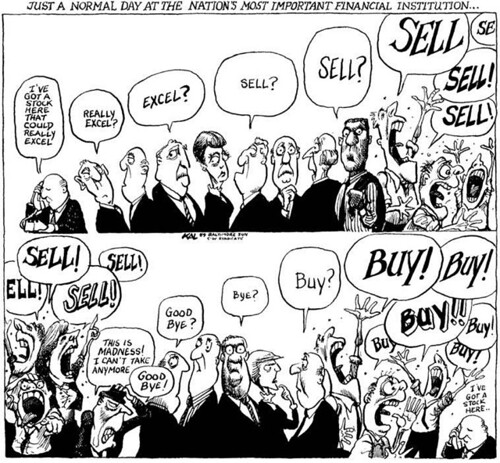Option trading is one of the more mysterious ventures on Wall Street. Many traders simply do not understand how they work. They often hear the statement that options are risky and volatile. This is true, for the most part. Not all options carry the same risks. Options are all about probabilities, and this can be said of all trading. The biggest risk in trading is the loss of capital. Wiping out your trading account puts you out of the game. Trading deep-in-the-money options offers a way to control risks and conserve precious capital.
Swing traders and position traders can benefit by substituting deep-in-the-money-options for stocks. The vast majority of options traders buy at-the-money or out-of-the-money contracts. Most of these types of options have no intrinsic value. They have much lower probabilities of ending up with value at expiration. Outrageous percentage gains can be made with buying cheap options. The main problem is that it is often difficult to be consistent with this strategy. You need to see a large move in price before these options become profitable. The fact is, most price moves in the markets are small. For higher price stocks, it is normal to see moves of $1 to $5 in both directions. This is where a strategy trading deep-in-the-money options can be practical.
For example, let's look at trading a $70 stock. I buy 500 shares and the cost is $35,000. Commissions will be omitted. The target selling price is $74. I will take profits at that price. This stock is near a support price of $69, so I set a stop at $68.70. If the price falls below this level, I will sell it to protect my downside risk. The trade lasts for a week. For comparison purposes, any of the following five outcomes occurs. The stock doesn't move much in price and I sell it at $70 for a break even. The stock rises to the target price and is sold for a $2,000 gain. The stock takes off on good news and rises to $83 and I sell for a $6,500 profit. The stock fails to rise and the price stop is hit at $68.70 , for a loss of $650. The stock gaps down below the stop price on bad news and I end up selling it at $55. The loss is $7,500 because the stop failed to protect my risk of loss since it was never hit.
Keeping in mind that the objective is to keep losses from eroding my capital base, I will look at the same trade using deep-in-the-money-options. I buy five $55 call contracts at a price of $1,530 each for a total of $7,650. These options are $15 in-the-money ($70-$55). Five call options are equal to 500 shares of stock. Call options will gain in value if the stock rises. These deep-in-the-money options have a delta of 93 with three weeks until they expire. This means that the price of the option will move about the same dollar amount as the stock. This is one advantage over trading cheaper options. They have lower deltas and will move up in price by a lesser amount for every dollar move in the stock.
First off, notice the difference in total costs. The stock was bought for $35,000. The deep-in-the-money options cost was $7,650. Thus, I have significantly lowered my overall market risk. Over $27,000 remains in my account to collect interest. I have essentially set up the same trade using deep-in-the-money options. I now have plenty of capital left to add a few other positions in some other trading opportunities. If I wanted, I could create similar positions in three or four other options with the same capital I used for one stock. I could even hedge my original option purchase by adding cheaper put options to protect against a major fall in price.
I have limited my total possible loss on this trade to the cost of the option position ($7,650). The stock could fall off a cliff and lose half its value in a day or two. The stop I had placed to limit my losses would only work if the price drops through it or trades back up to it. If I buy the stock, about the only way to protect against a large gap down in price is to use a put option. Since I only plan on holding the position for week or less, the chance of a dramatic price drop is fairly slim.
The results for the option trade compare favorably to the stock trade. If the stock price stays the same, I can close my option position for about the same price I paid for it. There was very little time value in the cost because it was a deep-in-the-money option. At most, I might lose $20 or $30 a contract because of the option spreads (the difference between the bid and ask price). The cheaper options that I could have bought had much more time value. As time passes, the stock might not change in price, but the option will still lose value. I avoided this problem by using deep-in-the-money options. This is a main concern with cheaper options. They have time working against them.
Next, with the stock at $74, my options can be sold for $1,900. This represents a gain of $370 or $1,850 for the five contacts. This compares to the stock gain of $2,000. It is slightly less, but remember I reduced my trading risks. With the stock at $83, I can sell the options for a total gain of $6,350. Again, this compares well to the stock gain of $6,500. In both cases, the difference in profits was only $150. On to the last two results. The stock falls to the $68.70 stop and I sell the option position for $1,380 a contract or $6,900. This gives me a loss of $750 verses the stock loss of $650. Not a big difference at all. Finally, the stock is at $55 and my options are sold for $300 each, or a total of $1,500. The loss is $6,150 compared to the stock loss of $7,500. The difference occurs because the $55 call options are now at-the-money. This means they have a time value attached to the premium. By using deep-in-the-money-options, I reduced my risk of suffering a major loss. That is one of the key axioms of trading; to preserve capital at all costs.
Trading deep-in-the-money options can work for just about any size account. They work well for targeting small gains in all kinds of market conditions. Deep-in-the-money put options can be used to take advantage of moves to the downside. Directional trading for small gains can be extremely profitable as long as losses are contained and kept to a minimum. Trading for one to three point gains can add up over time. There are far more setups for this type of trading. Risks of a major trading loss can be virtually eliminated with deep-in-the-money options. By their very nature, deep-in-the-money options have higher probabilities of maintaining value. This is where success can be found. It hides in places that few traders ever consider investigating.
stock promoters






